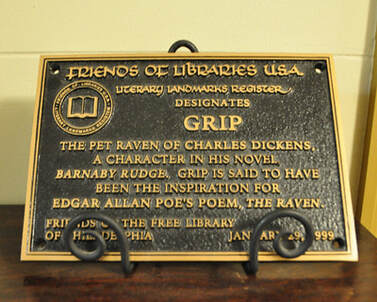Poe, Dickens, and Ravens
|
These pictures of Charles Dickens and Edgar Allan Poe differ from the ones we often see of them. Dickens is generally depicted as portly and avuncular and Poe as mustached and haunted. But in these portraits, both appear healthy, handsome, and in their prime. Both wrote fiction about solving crimes, including murders. Poe invented the basic patterns of the detective genre in a handful of stories in the early 1840s. Dickens's novel, Bleak House (1852), features a murder investigation. Foul play is suspected in his final novel, The Mystery of Edwin Drood, left unfinished when he died in 1870. The two writers have even more in common.
Charles Dickens visited America in 1842 and met Edgar Allan Poe in Philadelphia. Poe had favorably reviewed the 1841 serialized Dickens novel, Barnaby Rudge. That novel included an unusual character, a talking raven. The bird was named Grip after the Dickens family’s pet raven. Three years later, Poe’s best-known poem, The Raven, was published. Literary scholars believe that Grip inspired the poem, and there are similarities between Grip and Poe's raven. A character in Barnaby Rudge hears Grip and says “What was that . . . tapping at the door? Tis someone knocking softly at the shutter. Who can it be?” Compare those words with Poe's: "...suddenly there came a tapping, As of some one gently rapping, rapping at my chamber door." When imprisoned with Barnaby, Grip's vocabulary is reduced to one word that he repeatedly croaks: “Nobody.” Poe's raven also repeats a single word: “Nevermore.” Draw your own conclusions. After Grip died, Dickens had the bird stuffed and mounted. A collector of Poe memorabilia eventually bought the stuffed bird at auction and brought it to America. The raven Grip, looking as he did when he was in the Dickens household, is now in Philadelphia, where his owner and Poe met 180 years ago. The bird resides in the Free Library of Philadelphia. A plaque there commemorates the relationship of Grip, Dickens, and Poe. |



